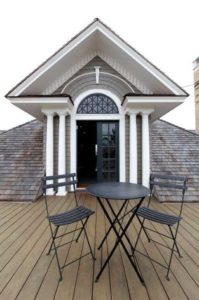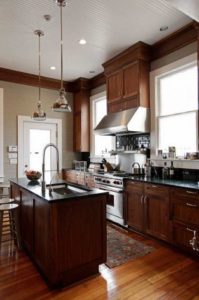Today marks my five year anniversary with King William Realty. I am so blessed to be associated with such a great agency! I look forward to many more prosperous years ahead.
King William Realty listing featured in Spaces
One of our King William Realty listings was recently featured in the San Antonio Express-News Spaces section. This is an amazing property!
Spaces: A multifamily mess transforms into a neoclassical gem
By Karen M. Davis Photos by Jerry Lara
Friday, March 4, 2011
When Kevin Browne first saw the three-story neoclassical mansion in the area south of downtown often referred to as Baja King William, it was a far cry from the elegant residence built in 1907 by James Luby, a judge from Duval County.
Its three floors had been broken up into four apartments, with walls in places they weren’t meant to be. A former carriage house in the back had been divided into two small apartments. Both structures had been poorly maintained.
“It was a mess,” Browne says.
But he saw the possibilities and had the desire to bring the house back to its former glory. He bought it and hired an architect to draw up the plans. In July 2008, construction began.
Browne located descendants of the original owners, who gave him photos of the house in its heyday. After almost two years of construction, the renovations were finished last April. And the result is a 4,600-square-foot showplace that combines an early 1900s flavor with modern conveniences.
Outside, large, rounded porches are supported by tall cypress columns with carved capitals. Each floor has its own porch, and the upper porches offer great views of downtown.

The Brownes can relax and enjoy the view from the third-floor balcony. It faces downtown and offers a great view of New Year’s Eve fireworks. Photo: SAN ANTONIO EXPRESS-NEWS, JERRY LARA
Inside, Browne restored the original long-leaf pine floors. There are seven fireplaces. The high ceilings and large windows popular in an era before air conditioning give the interior an expansive feel.
The entry room’s fireplace has a marble surround that Browne ordered from New York to replace the original brick structure. Built-in storage benches flank the fireplace. A round table in the center of the room sits on a zebra-skin rug that Browne’s wife, Jody, bought at the annual Olé Marketplace.
The adjacent library has another fireplace, bookshelves and an antique Persian rug. Behind the library is the family room, featuring a chandelier a friend brought back from Morocco and a marble fireplace that once was in the Plaza Hotel in New York.

The sitting room is located between the library and the dining room and features a chandelier from Morocco. The marble fireplace originally was in New York’s Plaza Hotel. Photo: SAN ANTONIO EXPRESS-NEWS, JERRY LARA

The library room is located to the left of the front entrance and features a fireplace. Photo: SAN ANTONIO EXPRESS-NEWS, JERRY LARA
Behind the family room is the formal dining room — an oval room with a coved ceiling and a mahogany fireplace. The dining table is an antique purchased from a friend, and the chairs are a “vintage find,” Jody Browne says.

The formal dining room of Kevin and Jody Browne’s home is oval shaped and features the original windows and a mahogany fireplace. The table and chairs are antiques. Photo: SAN ANTONIO EXPRESS-NEWS, JERRY LARA
Off the dining room is the former butler’s pantry, which now is used as a breakfast room and wine storage and serving area. The adjacent kitchen has been updated with black soapstone counters, an island and walnut cabinets. A big Wolf stove dominates one wall.
On the second floor, a sign painted on one door says “smoking room.” It’s now used as a music room. An unusual feature is the triple-hung casement window that’s used instead of a door to access the second-floor porch.
Next to the music room is an office, also with its own fireplace, and the back of the house includes the master suite and an enclosed back porch that has space for a day bed, eating area and laundry. The master bath is done in limestone, with op-art tiles in the walk-in shower.
The third floor is an open area with large closets, a kitchen and a bathroom. It’s the domain of Jody’s 15-year-old son.

The third floor bath has hardwood floors and classic fixtures. Photo: SAN ANTONIO EXPRESS-NEWS, JERRY LARA
While the house is large, the rooms have been kept their original sizes.
“I love that,” Jody says. “It’s cozy, even though it looks so huge from the outside.”
Austin Modern Home Tour – This weekend!
I’m so excited to be attending my first Austin Modern Home Tour this Saturday. I’m hoping the temperatures warm up for it!
They’ve set up a great website with a preview of all the homes on the tour.
http://www.modernhometouraustin.com/
I’ll be sure to take lots of photos and post them up later.
Let me know if anyone wants to ride up with me on Saturday.
SOLD – 521 Wickes St in King William
My client recently purchased this great home in the King William Historic District.
Please let me know if I can assist you in your home search and purchase.
Renting Downtown
***This post was originally published in August 2010 and has become one of the most read posts of my blog. Due to its popularity I’ve moved it to the landing page on my site. Please click here for the list that I keep up-to-date as a lot more inventory has been developed over the past couple of years. Places to Rent in Downtown and Southtown ***
Four years ago I moved from the northern suburbs to Milmo Lofts off S. Flores and Durango. I found it very difficult to track down an apartment as there wasn’t a formal list of places or a website that had everything listed. Also at that time I was just getting my real estate license so I didn’t have access to the MLS or really even know any good downtown real estate experts.
Fast forward four year and A LOT has changed!!! I’m now a downtown real estate specialist, friends with all the other downtown agents, and the demand for downtown living as spawned several new downtown apartment complexes.
Jennifer Hiller at the Express-News wrote this great article.
A few years ago, people who wanted to rent an apartment downtown took whatever they could find because the options were so limited.
Now, however, there’s a bigger variety of housing downtown and renters are more likely to be able to choose between small studio spaces, rental homes or large lofts — without the expense and hassle of making a big down payment on a mortgage.
“You don’t have to buy downtown. You can rent,” said Lisa Schmidt, a downtown resident and real estate agent.
While San Antonio’s downtown still is in the early stages of residential demand compared to other major cities, living downtown is drawing in more and more people who are lured by what the lifestyle has to offer.
Many of the new downtown renters are military people who have been transferred to San Antonio as part of the growth at Fort Sam Houston under the Base Realignment and Closure process, said Debra Maltz, a broker and real estate agent with Centro Properties.
“The BRAC folks have made a difference. A lot of them don’t want to buy because they know they’re here for a finite period,” Maltz said. “They’re used to living in other cities downtown. I think that’s had an effect on downtown. They like the whole concept of living in a closer-knit community, which downtown offers.”
Young singles long have been attracted to downtown rentals, but Maltz said that now empty nesters are selling larger homes and trying out urban living.
They’ll often rent for a year to decide if they like the lifestyle.
Some of the newest large rental properties include the Vistana, a 247-unit Art Deco-inspired apartment building that opened in 2009 on
North Santa Rosa and the 66-unit St. Benedict’s on South Alamo Street, a King William-area project originally planned as condos but converted to a successful rental development.
The San Antonio Housing Authority recently opened HemisView Village Apartments across from HemisFair Park.
Although a handful of the 245 units are set aside for public housing or those who qualify for affordable-housing tax credits, 184 units are being rented at market rate to the general public.
The project includes balconies, a pool, a parking garage, a fitness and amenity center, and many units with big storefront-style windows and views of the Tower of the Americas.
“We’re really proud of the look and the feel,” said Lourdes Castro Ramirez, president and CEO of SAHA.
Market-rate rent ranges from $741 for the smallest units to $1,314 for a three bedroom. And the public housing units are scattered throughout the two buildings, with the idea of creating a true mixed-income community. “It’s definitely the future of public housing,” Ramirez said. “From a financial perspective, it’s the only way you can make project work. From a social policy perspective, you have more role models and an environment where people can socialize across economic groups.”
Although it’s not in downtown proper, new rental units soon will be available at the Pearl Brewery’s new Culinary Institute of America building, just north of downtown off of Broadway. The 25,000-square-foot structure will house several restaurants and be neighbor to apartments, the Twig bookstore, a third location for Bike World and a 1,000-seat amphitheater.
But on the upper floors there are also eight apartment units, including two penthouses. Maltz said recently that five units were pre-leased. “There is a huge demand to live at the Pearl Brewery,” she said.
Architect Jim Poteet, a longtime resident of King William who is known for his modern renovations of historic properties, said that for a long time it seemed that home and condo owners were the only ones living downtown. “I think the rise of rental is the thing that’s now bringing people downtown to test the waters. As a format it can be apartments, lofts, faux lofts or condos,” Poteet said.
And more rentals make sense as part of larger economic trends, he said. “I think the economy has shown people that homeownership, that urge to buy a house or to have a house as the cornerstone of your financial portfolio, was overstated. It feeds into a rental trend,” Poteet said. “It’s all to the good for downtown. We need all kinds of housing. We need ownership. We need infill projects. We need rental.”
And if people want to rent a more traditional home, there’s the historic King William and Lavaca neighborhoods, which have some rental homes and smaller offerings, such as garage apartments. Maltz recently rented a new contemporary house that’s tucked into Lavaca.
“You see infill housing a lot in Houston and Dallas. I think it’s wonderful that we are starting to see it here,” Maltz said. “It’s so expressive and so urban.”
Some of the places where you can rent downtown:
12welve 2wenty1 Loft Apartments – 210.354.1212
235 E. Commerce Apartments
Majestic Towers/Brady Bldg Apartments, 222 E. Houston St. – 210.224.1144
Pearl Brewery, 306 E. Grayson St.
Vistana, 100 N. Santa Rosa Ave. – 210.226.5638
720-724 N. Saint Mary’s Apts.
Blue Star Residences and Lofts, 1410 S. Alamo St. – 210.225.6743
The Brackenridge at Midtown, – 210-822-2500 (Opening January 2014)
Cadillac Lofts, 317 Lexington Ave. – 210.223.5638
Calcasieu Building Apartments, 214 Broadway – 210.472.1262
Can Plant Residences at Pearl, 503 Ave. A
Casa Lavaca, 502 Eager St.
Cevallos Lofts – 866.295.0250
Dielmann Lofts, 710 S. Medina St. – 210.223.1178
Exchange Building, 152 E. Pecan St.
Granada Apartments, 301-11 S. St. Mary’s St. – 210.225.2645
HemisView Village, 401 Santos St. – 210.212.8808
Losoya Building, 221 Losoya
Marie C. McAguire Apartments, 211 N. Alamo St. – 210.477-6378
Maverick Apartments, 606 N. Presa St. – 210.886.9555
Metro House, 213 4th St. – 210.271.0051
Milmo Lofts, 319 S. Flores St. – 210.223.1178
Morris Apartments, 128 E. Main Plaza – 210.225.3188
Palacio del Sol, 400 N. Frio St – 210.224.0442
Refugio Place, 300 Labor St.
Reuter Building, 217-219 Alamo Plaza
Robert E. Lee Apartments, 111 W. Travis St. – 210.354.1611 email: robert_e_lee_apts AT prm DOTCOM
Soap Works Apartments, 500 N. Santa Rosa Ave. – 210.223.9500
The Madison, Madison at Beauregard streets – 210.544.5416
Tobin Lofts, N. Main at San Antonio College Campus – 888-696-3145 (You must be a student of any higher education institution in the US.)
Toltec Apartments, 131 Taylor St.
Town Center Apartments, 601 N. Santa Rosa Ave.
Villa Hermosa, 327 N. Flores St. – 210.477.6611
Whitherspoon Building, 601 N. Alamo St.
Source: Downtown Alliance
Fannie Mae issues guidance on appraisal quality standards
This is a great article by Washington Post Housing writer Ken Harney. I’m glad to hear that Fannie Mae has listened to buyers, sellers, REALTORS, and lenders and have made changes to the way appraisals will be conducted. These changes begin September 1st.
By Kenneth R. Harney
Saturday, July 10, 2010
Picture this: You’ve signed a contract to sell your house. Your buyers say they have nailed down the right mortgage. All is well. But then the appraisal comes in low — $25,000 to $50,000 under what was agreed upon in the contract.
The lender insists on cutting the mortgage amount to reflect the lower appraised value. You refuse to negotiate anywhere near the price indicated by the appraisal, and suddenly — poof! The whole deal is off. You, the buyers and the agents involved are all left sputtering over the appraisal that scuttled the transaction.
This scenario is not unusual in many markets across the country, say home builders, brokers and appraisers. Here’s one little-publicized reason why: Lenders unilaterally may be lowering the numbers on the appraisals submitted to them, in order to avoid accusations that the loans they sell to giant investors Fannie Mae or Freddie Mac are based on inflated appraisals — even slightly inflated. Such value inflations can expose lenders to dreaded “buyback” demands, forcing them to repurchase loans at huge costs.
The vice chairman of the National Association of Realtors’ Appraisal Committee, Frank K. Gregoire of St. Petersburg, Fla., says it’s a widespread problem. Large numbers of legitimate home sales are “sabotaged by lenders and underwriters arbitrarily reducing the value estimate” provided by the appraiser.
Typically, Gregoire says, the lender orders a low-cost electronic valuation — based on publicly available statistical data, with no onsite inspections — to review the accuracy of what was submitted by the appraiser. If there’s a discrepancy between what the computer says and what the appraiser reports, the lender’s underwriters sometimes simply cut the number — even if this means knocking the real estate transaction off track. Or they demand an immediate explanation from the appraiser.
All this may be about to change. Effective Sept. 1, Fannie Mae is prohibiting lenders who sell it loans from changing appraisers’ numbers. In guidance issued June 30, Fannie said lenders must contact appraisers to “resolve” any disagreements about the valuation. If that’s not possible, they should order a second appraisal — not just chop the value.
Appraisers applauded the new rule. “This is huge,” said Gary Crabtree, president of Affiliated Appraisers of Bakersfield, Calif., and a member of the national government relations committee of the Appraisal Institute, an industry group. Pat Turner, an appraiser in Richmond, said Fannie’s new requirement “is great news for consumers” because loan underwriters hundreds of miles from the property “no longer will be able to change the appraiser’s valuation” simply because they pulled a lower number off a computer.
Turner said these electronic models “are often inaccurate” and provide no information on a property’s condition. He said an appraisal completed recently in Virginia was challenged by a review company based in California using a proprietary electronic-valuation system. The reviewer wanted to know why Turner hadn’t used a specific property in the area as a “comparable” in doing his appraisal on the house. Turner checked out the suggested “comp,” and it turned out to be a vacant lot, worth far less than the house — not a true comp “by any stretch of the imagination.”
Fannie’s new guidelines also attempt to clarify other issues that have arisen during the past year, including the widespread use of inexperienced appraisers who are unfamiliar with local market conditions. Real estate agents, builders and mortgage brokers have complained to Congress that rules adopted by Fannie and Freddie last year encouraged lenders to use “appraisal management” companies to value properties.
Those companies, in turn, often pay appraisers deeply discounted fees — half off traditional prevailing rates in some cases — and require them to complete their assignments far faster than normal turnaround times. Critics have said that low-budget appraisers working for management companies frequently travel long distances to do their valuations, have minimal access to local data, and make excessive use of foreclosures and short sales as comparables — thereby depressing the values of non-distressed sales in the area.
Fannie’s letter attempts to clarify its “appraiser selection” standards. Top on the list: Appraisers should be experienced, “have the requisite knowledge” about local market conditions and have access to all local data sources. Fannie also emphasized that the demonstrated experience of an appraiser should always trump fees or turnaround times — a clear swipe at management companies that bid out their work on the latter two criteria.
Asked whether Freddie Mac plans to issue similar rules on appraisal-quality standards, a spokesman said, “We’re definitely looking at it.”






